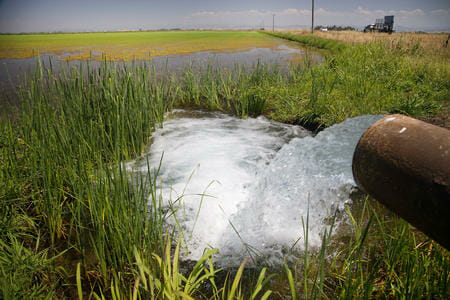

Groundwater used to flood rice fields in Yuba County, CA: Whether it’s a wet or dry year, California uses more water than is naturally available. And as climate change brings longer, more frequent droughts, rising sea levels, and floods (or even leads to near failures of our outdated water infrastructure like we recently saw at Oroville Dam), it’s critical that we prepare for the water challenges looming ahead.
Since farms use 80% of our water, it’s absolutely essential that we figure out how to make real and lasting changes that will save water. The state’s latest water conservation plan is a necessary next step to move the state toward a more sustainable water future, but it has at least one glaring flaw—it fails to include real changes that would conserve more water in agriculture, California’s largest water user.
This is like turning off the faucet when you brush your teeth but continuing to water the lawn around your uncovered junior Olympic-sized swimming pool every single day. It simply makes no sense.
While Gov. Brown has demonstrated strong leadership when it comes to reducing the water used in our homes and businesses, there’s more work to do to help […]
Full article: Where Is California Leadership on Ag Water Conservation?
News: New Study Demonstrates Water Conservation Pays Off for Ratepayers
Share the Wealth: A Cap-And-Trade System of Water Conservation and Resiliency?
A Cheerful Story About Environmental Conservation (Really and Truly)
Clean water is essential for life, yet millions of Americans unknowingly consume contaminants through their…
Human brains contain higher concentrations of microplastics than other organs, according to a new study, and the…
From the Office of the Governor: In anticipation of a multi-day, significant atmospheric river in Northern California,…
From Governor Newsom: Scientists, water managers, state leaders, and experts throughout the state are calling…
Photo: A harmful algal bloom in Milford Lake, Kansas, made the water appear bright green.…
An expanded plastic foam coffee cup is at a donut shop in Monterey Park, California.…